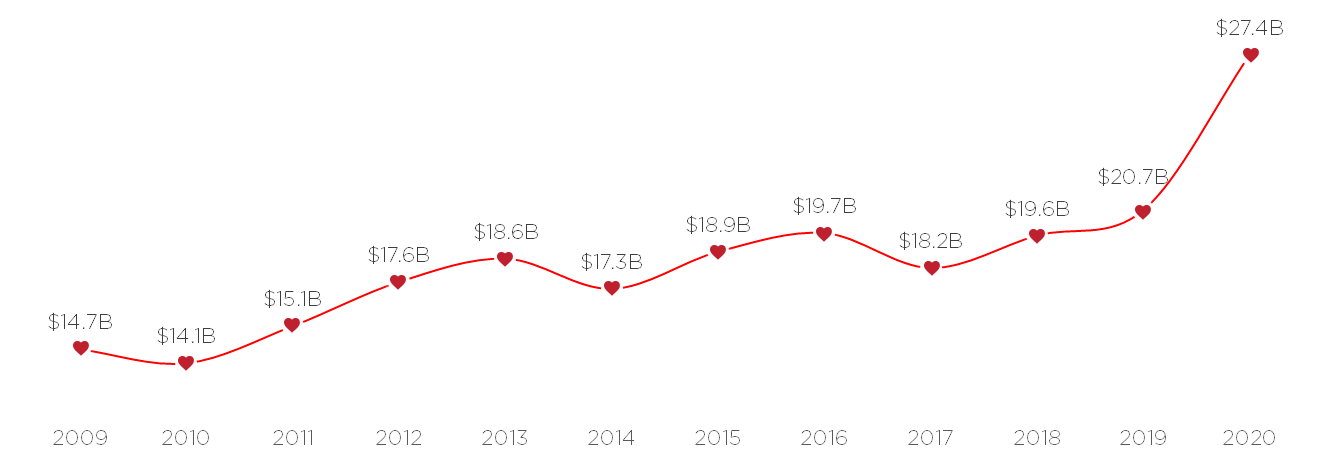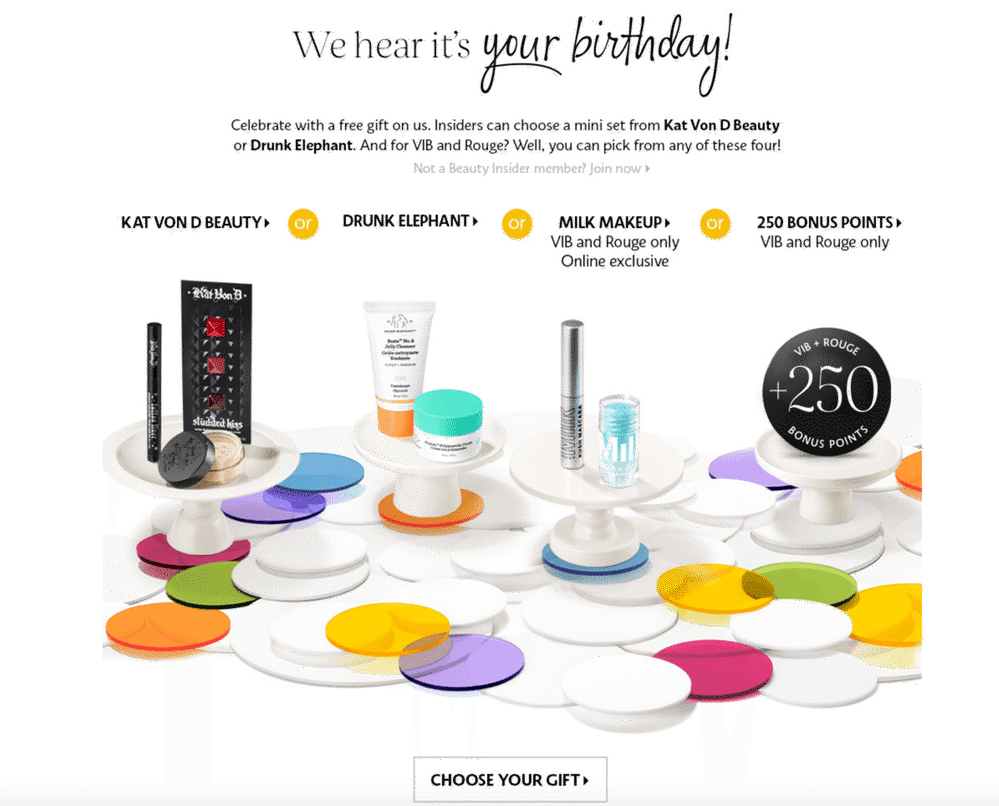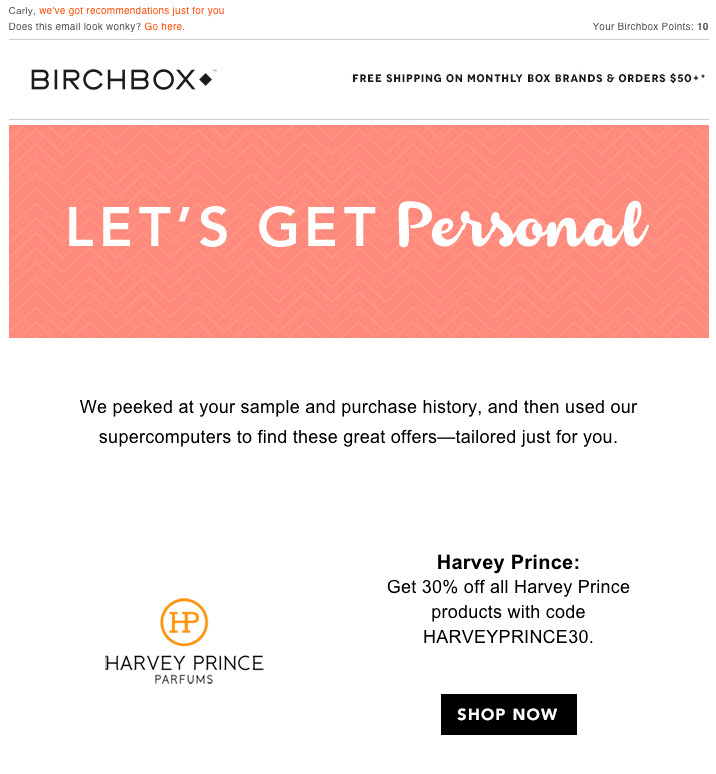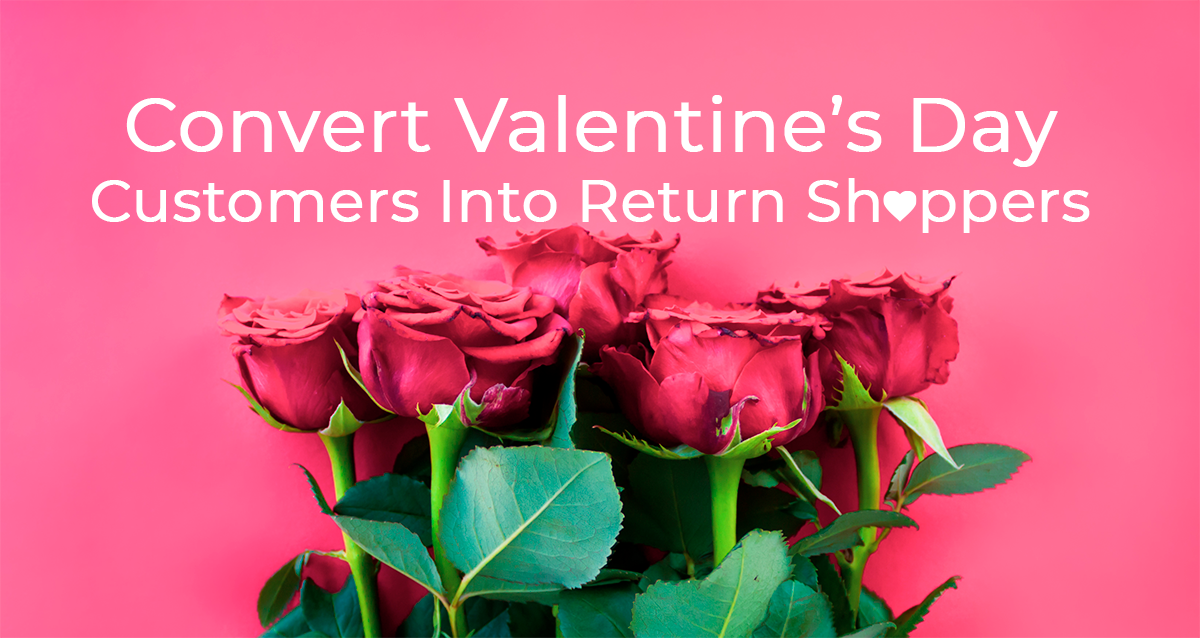True love has a habit of coming back, and what better time to foster customer loyalty than during Valentine’s Day?
The feelings and emotions that you evoke from a potential customer form how they identify with your company, and positive emotions can boost your brand’s personality—which studies demonstrate can also make you more memorable.
How big is Valentine’s for retailers?
This year’s Valentine’s Day is forecasted to smash spending records. According to the National Retail Federation, who have been surveying consumers about how they plan to celebrate Valentine’s Day for more than a decade, shoppers plan to add $27.4 billion to our global economy—that’s almost $7 billion more than the $20.7 billion spent in 2019.
The up-surging trend of Valentine’s Day sales over the last ten years points to increasing online sales; This is great news for eCommerce as online shopping is one of the most popular Valentine’s Day shopping destinations at 32 percent of all sales (department stores remain the most popular at 36 percent).

National Retail Federation: Historical spending ($ billions) for Valentine’s Day.
Some of this growth can be attributed to participation levels; more than half of all active consumers will be participating in Valentine’s Day this year, and that’s a higher percentage than last year. Lovebirds will be spending a record amount of $196.31 per person. That thumps the 2019 record of $161.96 per person.

The gift of love is universal
A box of chocolates is no longer limited to your true love. The act of gift-giving now also extends to friends and family, work colleagues, classmates and peers, and even our pets. Even more exciting news? You don’t have to retail traditional Valentine’s Day gifts, either—many non-believers are still buying “anti-Valentine’s Day” gifts.
And let’s not forget Singles Awareness Day! This is celebrated the day after Valentine’s Day, typically for those who are unattached and without a significant other. Another vast, mostly untapped retail opportunity.

Your courting strategy
The stats above don’t lie, and we can confidently agree that Valentine’s Day is a fitting holiday to attract new customers and to get your existing customers to renew their vows with you, so to speak.
To do that, though, you need a game plan—after all, it’s not easy to land a fish in this enormous sea of love. You have to make all the right moves, emotionally speaking, to entice your customers to identify with your company, have your brand generate the positive emotions they crave, and to get them to commit, stay with you and be loyal once the holiday passes. So, let’s get to it.
Give existing customers the VIP treatment
It’s not enough to have an awesome website design and to just tell your customers how much they mean to you; you need to show them. Remember, actions speak louder than words in the game of love. One way to accomplish this is to present an inclusive Valentine’s Day offer to your existing customers.
Giveaways are an excellent way to make existing customers feel special while positioning yourself as a thoughtful brand that has real people with genuine emotions working behind the scenes.
Everyone loves free stuff, so put together a thoughtful gift basket of popular items you sell or a gift card to your store that they can redeem when they come in.
Sephora is famous for giving away a complimentary birthday gift to all customers who have enrolled in their Sephora Beauty Insider Program—this is a beautiful use case and example of valuing the ones you love.

Poetry is most charming
How do you woo your customer base? Freebies, promo codes, and giveaways are fantastic, but poetry is pure conversion magic. What you say is important, but how you say it is what matters.
One size does not fit all 😉 so make sure you’re speaking to the desires of your entire base of customers. Many of your segments will have different budgets, so you need to provide affordable discounts and product incentives for those looking to save money, along with suggested bundles and more expensive items to those who might have a larger wallet.
Let’s also consider the 2018 Valentine’s Day survey done by WalletHub, where nearly half of all potential buyers expect their V-Day gift to cost around $50. So, if part or all of your customer base would tend to spend that amount, that’s where you want your promotions to land.
It sounds tough, but there are plenty of effective ways to do it. Personalized emails are a start, and tailored push notifications can nudge them further toward falling in love with your offer. It’s instant gratification based on a time-tested strategy, and it’s especially useful during an emotional holiday like Valentines’ Day.
Pro tip: It is estimated that nearly 50% of marriage proposals happen on or around Valentine’s Day, which means there are lots of couples looking for fun places to go hang out, eat, be entertained, shop, etc. Now, be careful not to get caught up in promoting solely to couples — you don’t want to alienate your single customers.
No one finds insensitivity attractive. Even if you think you know your customer’s most inner desire, things can get problematic when it comes to guessing about their current relationship status—not everyone will be in a relationship this Valentine’s Day, but as mentioned previously, it’s not just a holiday for couples. Single people regularly get gifts for themselves on Valentine’s, with 14% of women sending flowers to themselves. So again, ensure you’re inclusive of all of your shoppers by acknowledging the single individuals or same-sex couples.
Birchbox is obsessed with personalization in all the right ways, and you can see this with a peek at their email header in the example below:

The whole commitment thing
What’s more important in love and romance than commitment and loyalty? Commitment may be tough to find in a relationship, but its surprisingly easy curate within a customer base provided that you’re willing to put in the effort.
Start by planning in advance. Sending out emails early and make sure to follow up in a timely fashion. Not quite sure where to start? We’ve crafted a holiday marketing calendar to assist with your Valentine’s Day outreach:
- INTRODUCE YOURSELF. Last week of January: Send your initial introductory email offer.
- ASK THEM OUT. February 1st or 2nd: Launch your Valentine’s Day promotions.
- YOUR FIRST DATE. February 5-7: Send a gentle reminder to make their purchase in advance with a discount attached to drive incentive and conversion.
- GET ENGAGED. February 9-10: Announce last-minute rushed shipping specials targeted at those who haven’t yet purchased.
- THE BIG DAY. February 14: Hit up those panicking, last-minute shoppers with an e-gift card that doesn’t require mail delivery and can be instantly downloaded.
Once the holiday passes, you can sweeten the deal to ensure customer commitment. For instance, offer BOGO deals or knock a significant percentage off your regular purchase price as a one-timer. The key here is selling the scarcity; use phrases like “One day only,” “Ends at midnight,” or “Don’t miss out.”
One last caveat about commitment. Not all of your customers will be into it—in fact, studies have shown a marked increase in fraud attempts after holidays like Valentine’s Day when orders spike.
That means enhancing your customer experience with increased security as you track and use the data, so you can identify and fix any holes that fraudsters are trying to exploit to take advantage of you. It may not be the sexiest part of your V-Day strategy, but it could save you lots of money and plenty of hassles in the long run.
One last word on consumer courtship
Whether you’re in love or despise the traditions of Valentine’s day, companies are tremendously conscious of the potential revenue streams that the day generates. And, every business must have a strategy to foster long-term customers—consider that even a five percent increase in customer retention can bump up the profitability of your business by 75 percent.
If you’re reading this a little late, don’t worry. This advice can be applied during any major holiday. Plan ahead of time to guarantee that you can fully execute your holiday strategy and track your efforts.
The goal is to create a sense of advocacy, that classic warm and fuzzy feeling that will help to reignite the flame for those long-term relationships. And that’s what we’re all chasing, right?

